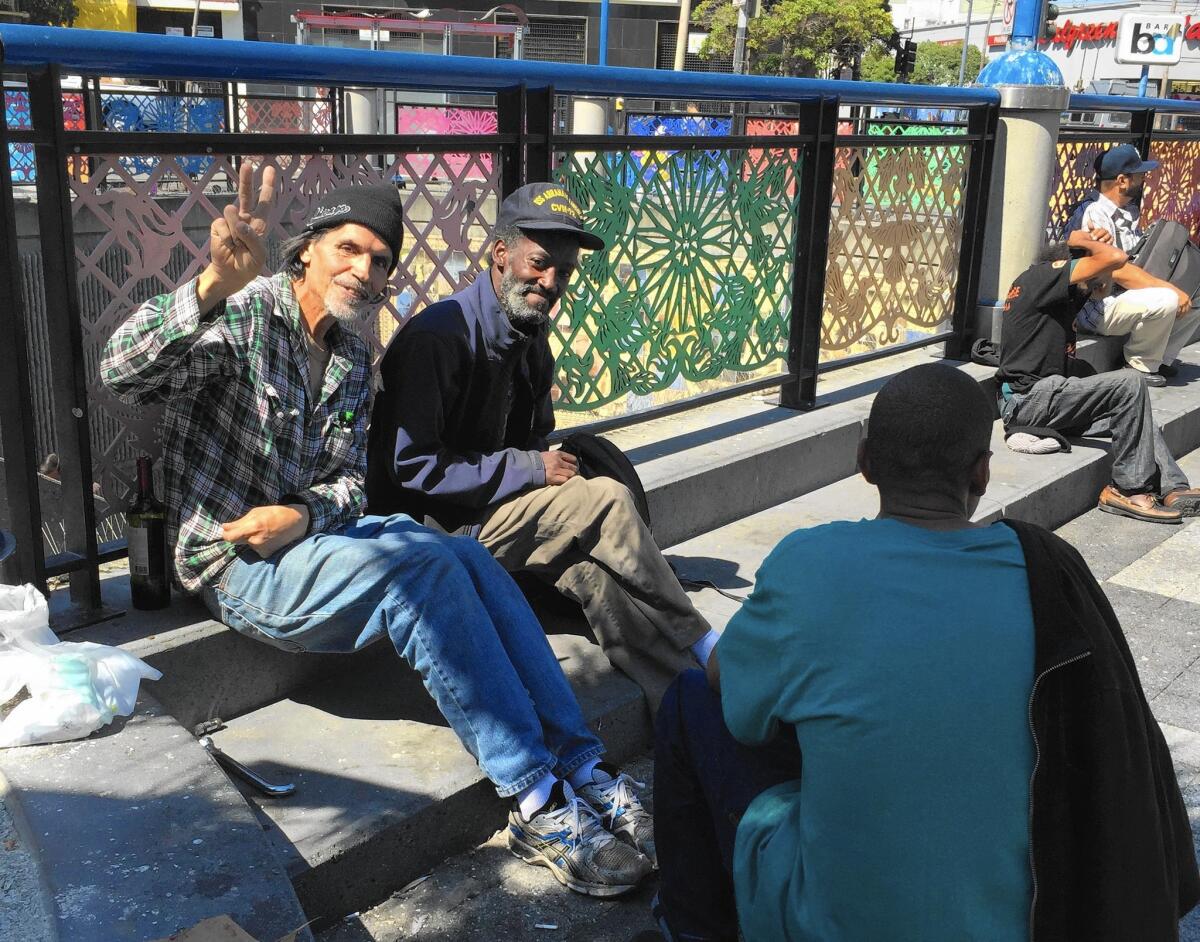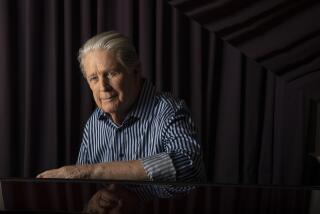How the drought has affected San Francisco’s devastating lack of public restrooms

At the BART plaza at 16th and Mission streets in San Francisco, Bill Garza, left, and Ronnell Hunt talked about how hard it is to find a restroom.
- Share via
SAN FRANCISCO — There are a lot of people whose lives have been adversely affected by the unrestricted flow of urine on the streets of San Francisco. On a hot summer day, the stench in some neighborhoods — the Tenderloin, the Mission and South of Market — is nearly unbearable.
But few people have come close to death-by-urine the way Luis Gomez did. Gomez, 40, is a barber. He commutes from the East Bay suburb of Concord to work at Metropolitan Barber Shop, a hip Nob Hill spot.
On a Sunday earlier this month, while the BART system was down for maintenance, Gomez drove his 1994 Honda Accord into the city. He had just bought it for his 15-year-old son, Adrian, who is learning to drive.
Late in the day, he was in the Honda, heading home. A friend was in the passenger seat and Adrian was in the back. As Gomez waited for the light to change at Taylor and Pine streets, two blocks from the Fairmont Hotel, he heard a loud crack. “Then,” he said, “the windshield broke all over us.”
A three-story metal light pole, with the street sign attached, had fallen across his hood. “I was in shock,” he said. “I saw people talking to me, but the noise that it made — I couldn’t hear anything.”
No one was hurt, but the car was totaled.
And here’s why the story made news far beyond San Francisco: Officials speculated that urine, both human and canine, had contributed to corrosion at the base of the metal pole.
Something new to worry about: Urination devastation.
::
The historic drought has afflicted Californians in many different ways. Suburbanites have had to reconsider the concept of the verdant lawn. Farmers have had to fallow fields. Merchants in San Francisco, it would seem, have stopped washing down their streets.
Water conservation, combined with a dearth of public restrooms, has led to an olfactory assault on denizens and tourists. “It’s not very pleasant,” said Sergio Calle, a 25-year old attorney from Madrid who stood in line for a cable car at Market and Powell Streets. “But there’s really nothing you can do.”
Au contraire, say city officials.
For the last year, the San Francisco’s Public Works department has brought clean, well-lighted solar-powered portable toilets with sinks, complete with bathroom attendants, to smellier parts of the Tenderloin during designated hours. Complaints about smelly sidewalks in those neighborhoods have fallen dramatically, said the city’s jovial public works director, Mohammed Nuru.
Nuru has also imported urine-repelling paint from Germany, which was developed to deal with the mess left by bar patrons in Hamburg who relieved themselves in public after last call.
So far, city workers have covered nine walls in key areas with the paint, which is supposed to bounce the urine back onto the shoes of the offending party. (Might I suggest the city apply this paint to its light poles too?) The city has also beefed up its steam cleaner crews, vowing to respond to calls about human feces within an hour.
“We’re the maids of the city,” Nuru told me Tuesday in his City Hall office. “The outdoors is our hotel.”
In the Tenderloin, at Eddy and Jones streets, I watched a group of small schoolchildren ushered across the street like ducklings by their teachers, who steered them around an unconscious man on the sidewalk and warned them to avoid stepping in two separate piles of excrement that I assumed were canine in origin.
“You sure about that?” asked Nuru’s spokeswoman, Rachel Gordon.
Despite my own fondness for bathroom humor, there’s really nothing very funny about not having a place to go.
San Francisco’s smelly streets are certainly made worse by the drought, but the underlying issues are the intractable trio of urban ills — homelessness, mental illness and addiction. A lack of public facilities exacerbates all that. There just aren’t enough places to go.
In certain neighborhoods, almost every restaurant and cafe has a sign in the window warning: “No Public Toilets.”
After 9/11, as a security measure, restrooms in most BART stations were closed. The San Francisco Chronicle reported last month that transit workers repairing a broken BART escalator at the Civic Center station found so much human excrement that they had to call in a hazmat team.
One of the most problematic intersections is 16th and Mission streets, where BART station plazas on opposite corners provide an inviting hangout for the destitute. There is one permanent public toilet on site. The local Burger King claims its restroom is out of order (always), so people urinate on the wall outside.
“We have people that sit out here all day long and drink beer and all of a sudden, they gotta go and they’re not gonna take a chance they can’t find a bathroom, so they hit a corner,” said Ronnell Hunt, 46, who lives in a nearby SRO hotel and was sitting with his friend, Bill Garza, next to the BART entrance. Behind Hunt, signs on a wall painted with urine repellent warned: “Hold It!”
“People poop in public like there’s no tomorrow,” Hunt said. “I will admit, I have had my moments where because of nerve damage, I can’t control it, so I have to go. I feel horrible. I feel humiliated. It brings a lot of discomforting feelings because you don’t ever want to feel like you are the type of person that will do like that on the street. But conditions have put you in that situation.”
Nuru gets that.
“A bathroom is probably even more meaningful than having a home or a place to sleep, frankly. It’s critical,” he said.
A good stretch of rain — perhaps this winter’s predicted El Niño — wouldn’t make things more pleasant for the city’s homeless, but it would do wonders for the city’s smell.
In the meantime, if you plan to spend time here this summer, bring your nose plugs.
And don’t forget, as Garza warned me: “Watch where you step.”
Twitter: @AbcarianLAT







